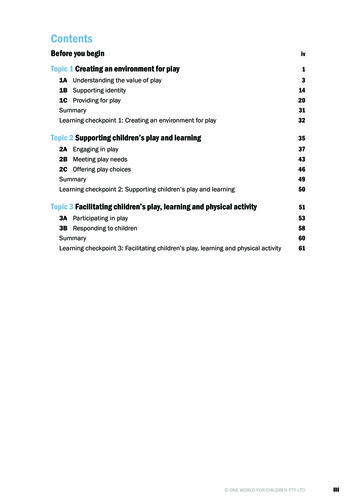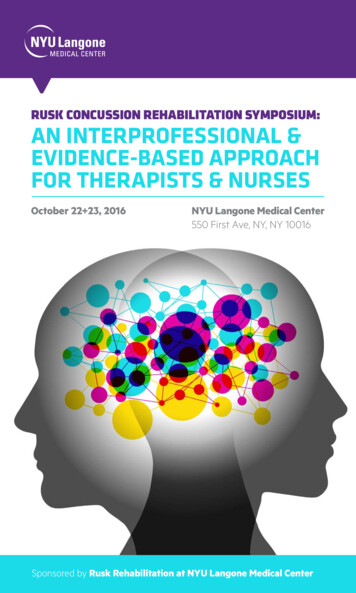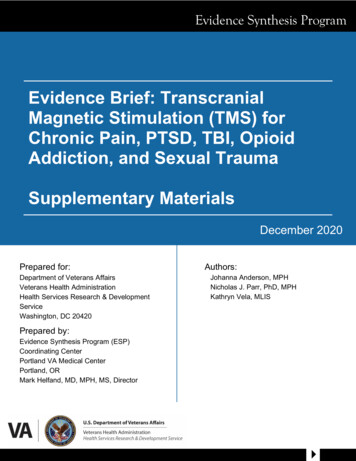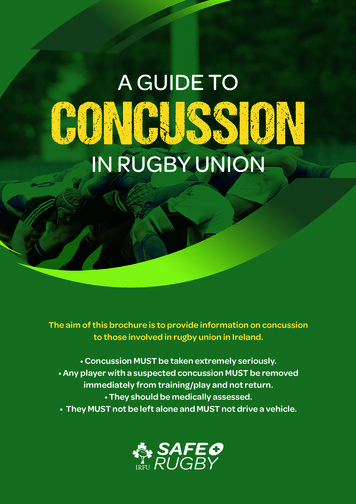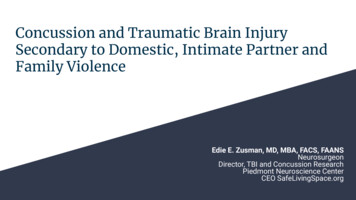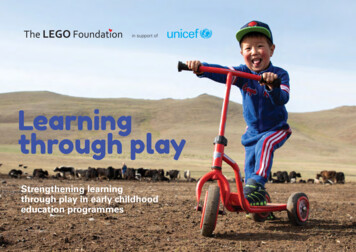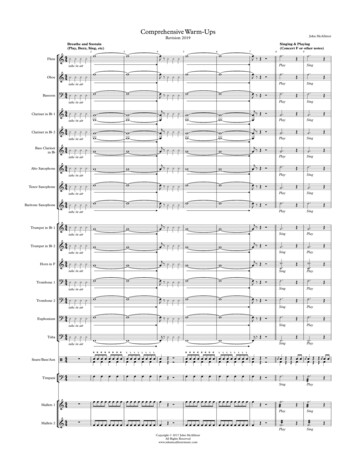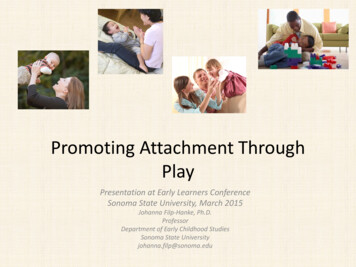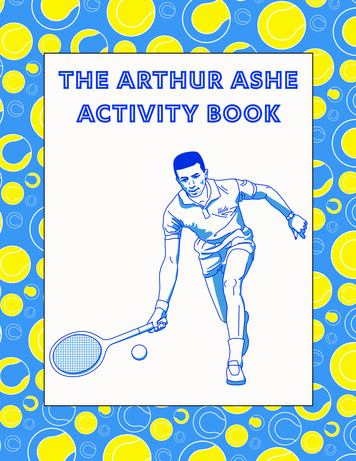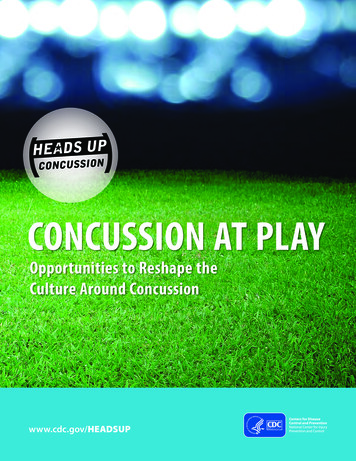
Transcription
CONCUSSION AT PLAYOpportunities to Reshape theCulture Around Concussionwww.cdc.gov/HEADSUP
Across the country, growing attention on concussion has led to numerous efforts aimedat protecting young athletes. While progress has been made, research suggests that toomany young athletes still do not report their concussion symptoms, are not removedfrom play and continue to play with symptoms, or return to play too soon.1-7Building from the work of the Institute of Medicine report Sports-Related Concussions inYouth: Improving the Science, Changing the Culture, this document provides a snapshot ofcurrent research on concussion knowledge, awareness, attitudes, and behaviors amongathletes, coaches, parents, health care providers, and school professionals. Based onthese findings, potential strategies to help keep athletes safe are provided.8All Concussions Are SeriousEach day, hundreds of thousands of young athletes practice and compete in a wide variety of sports.Physical activity, sports participation, and play in general are great ways for children and teens to buildand maintain healthy bones and muscles, lower their chances for depression and chronic diseases (suchas diabetes), learn leadership and teamwork skills, and do well in school.9,10 However, research shows thatwhen it comes to concussion, young athletes are at risk.A concussion is a type of traumatic brain injury—or TBI—caused by a bump, blow, or jolt to the head orbody that causes the head and brain to move rapidly back and forth. This sudden movement can causethe brain to bounce around or twist in the skull, creating chemical changes in the brain and sometimesstretching and damaging the brain cells.Most children and teens with a concussion feel better within a couple of weeks. However, for some,symptoms may last for months or longer and can lead to short- and long-term problems affectinghow a young person thinks, acts, learns, and feels. Parents, coaches, health care providers, and schoolprofessionals all play an important role in supporting young athletes so that they can thrive on theplaying field, at school, and in all parts of their lives.2All Concussions Are Serious
Many groups help create a sports culture for essionalsHealth CareProvidersResearch from separate studies shows that too many athletes:Do not report theirconcussion symptoms.Are not removed fromplay and continue to playwith symptoms.Return to playtoo soon.All Concussions Are Serious3
Concussion Knowledge and AwarenessOn the RiseGaps Still RemainAlong with the rise in the number of educationalefforts on concussion, research over the last 5 yearsshows that the level of awareness and knowledgeabout concussion among these groups has grown.For example:Even though knowledge and awareness ofconcussion is growing, research shows that thereare still important gaps to be filled. The majority of youth (ages 13–18) have heardabout concussion and understand the dangersof this injury.1,11 Most parents view concussions as a seriousinjury and know that continuing to play with aconcussion could cause further injury or evendeath.11,12 Many coaches are aware of general concussionsymptoms and understand that an athletedoes not need to lose consciousness to have aconcussion.1,13,14 Health care providers in many areas are aware ofand have access to referral networks for patientswith concussion.154Concussion Knowledge and Awareness Some parents are not familiar with stateconcussion laws or school or league protocolson children returning to learn and play.12,16 Coaches may not be able to identify subtleconcussion symptoms and may not be aware ofthe importance of managing cognitive activitiesfollowing a concussion.1,14,17 Some health care providers do not feel theyhave adequate training on concussion, andthe use of evidence-based and standardizedassessment tools and guidelines is limited.18–22 While similar research about school professionals’knowledge and awareness of concussion is notcurrently available, the important role that schoolprofessionals play in concussion identificationand management is clear.23,24
Concussion Attitudes and BehaviorsToo Many Young Athletes Do NotReport Concussion SymptomsAfter a Concussion, Young AthletesAre Returning to Play Too SoonReporting a possible concussion is the mostimportant action young athletes can take tobring their injury to light. Reporting symptomswill facilitate an athlete being properly assessed,monitored, and treated and taking needed timeto heal. Yet, research shows that too many youngathletes do not take this critical first step.1,2Young athletes should never return to play thesame day of the injury. In addition, they shouldnot return to play until an appropriate health careprovider says it is okay. However, many youngathletes are returning to play too soon following aconcussion.6,7In one study, researchers interviewed a group ofalmost 800 high school athletes during the courseof a season and found that:In a study of 150 young patients seen in anemergency department for concussion, many didnot take time to heal fully before returning to theirusual activities: Sixty-nine percent of athletes with a possibleconcussion played with concussion symptoms. Thirty-nine percent reported returning to playon the same day of their concussion.6 Forty percent of those athletes said that theircoaches were not aware that they had a possibleconcussion.2 More than half (58 percent) returned to playwithout medical clearance.6In a different study, 50 female and male high schoolathletes were asked what they would do if theythought they had a concussion: They most commonly answered, “I would keepplaying and see how I felt” or “I would take alittle break and return to play.” None said that they would stop playing entirelyif they experienced concussion symptoms.1Out of nearly 800 high school athletes interviewed,69% of athletes with apossible concussion playedwith concussion symptoms.2Out of those athletes,40% said their coacheswere unaware that theyhad a possible concussion.2Concussion Attitudes and Behaviors5
Opportunities toReshape the CultureAround Concussion
The Way Coaches Talk About ConcussionInfluences Young Athletes’ Decisions toReport Concussion SymptomsYoung athletes depend on their coaches for guidanceand need to feel comfortable in order to report theirsymptoms to their coaches, athletic trainers, teammates,and parents.1,25 In fact, young athletes’ beliefs about theircoaches’ expectations on reporting may trump their ownknowledge or intention to report a possible concussion.1,26The way coaches talk about concussion affects youngathletes’ behaviors around reporting symptoms: Young athletes who receive negative messages fromtheir coaches, or who are insulted by their coaches forreporting an injury, may feel pressured to keep playingwith concussion symptoms.1ACTION STEP: Coaches shouldfoster an environment where youngathletes feel comfortable reportinga concussion. Before and during theseason, coaches should talk aboutconcussion and ask young athletesto share and discuss their concernsabout reporting a concussion.WHY THIS IS IMPORTANT: Youngathletes are more likely to reportconcussion symptoms accuratelywhen they receive positivemessages about reporting fromtheir coach.1 On the other hand, young athletes who receive positivemessages from their coach and are praised for symptomreporting are more likely to report their concussionsymptoms.1Young Athletes May Feel Pressure toHide Their Concussion SymptomsResearch shows that despite the importance of reportingtheir concussion symptoms, many young athletes areunaware that they have a concussion or may not report apossible concussion because they: 3 Do not think a concussion is serious.1,3 Are worried about losing their position on the team or donot want to stop playing.1,3 Do not want to let their coach or teammates down.3,26 Are concerned about jeopardizing their future sportscareer or about what their coach or teammates mightthink of them.26ACTION STEP: Coaches shouldkeep a list of concussion signs andsymptoms and a concussion actionplan on hand and visibly postedwhere young athletes play gamesand practice. Coaches should reviewthis list frequently with their athletes.WHY THIS IS IMPORTANT:Most young athletes understandthe potentially dangerousconsequences of a concussion, suchas long-term disability and death.1Yet young athletes may be unableto identify some symptoms, like aringing in the ears or fatigue causedby a concussion.1,3Coaches also may have difficultyidentifying some subtle concussionsigns and symptoms, such as visionproblems, sensitivity to light andnoise, and problems with sleep.4,14,18Opportunities to Reshape the Culture Around Concussion7
ACTION STEP: Parents andcoaches need to communicate toathletes that a concussion should bereported no matter how importantthe game or event seems. Athletesshould know that health and safetyalways come first.WHY THIS IS IMPORTANT: Parentsand coaches greatly influence howathletes think about sports, such astheir motivation to play, enjoymentof the sport, goals, and decisionmaking.29,30.31 Young athletes maynot report their symptoms becausethey feel pressure from or worryabout letting down their coach,parent(s), or teammates.3Young Athletes Are More Likely to Play Witha Concussion During a Big GameYoung athletes may be more reluctant to tell a coach or athletictrainer about a possible concussion in a championship gamecompared to a regular game.27 Researchers presented thefollowing situation to 58 young athletes: “During a championshipgame, you develop an injury that does not significantly hinderyour ability to play, but could result in severe or permanent injuryif you continue to play. Do you tell your coach or athletic trainer,or do you say nothing and continue to play?” Fifty-two percent of young athletes said they would alwaysreport an injury during a championship game or event.27 Thirty-six percent of young athletes said that they wouldsometimes tell their coach or athletic trainer, while 7 percentsaid they would never tell their coach or athletic trainer aboutthe injury.27Similarly, the same researchers asked a group of 314 coaches ifthey would remove a young athlete from play with concussionsymptoms in different scenarios: Ninety-two percent of coaches reported they would removethe young athlete from play when the importance of thegame or event was not included in the scenario.28 When the scenario included a championship game,17–20 percent of coaches indicated that they would allowa concussed athlete to keep playing.288Opportunities to Reshape the Culture Around Concussion
Health Care Providers and SchoolProfessionals Can Help Young AthletesSuccessfully Return to Learn and PlayACTION STEP: Parents shouldreceive written instructions fromhealth care providers on return tolearn and return to play strategies.This information needs to be givento an athlete’s coach and school.As many as a third of young athletes do not receive cleardischarge instructions after going to an emergencydepartment with concussion symptoms.32,33 When dischargeinstructions are provided, health care providers often giveinstructions on return to play but not on return to learn.32,34WHY THIS IS IMPORTANT: Youthathletes and their parents needguidance to support them as theyreturn to learn and play. Coachesand school professionals will benefitfrom these written instructions aswell. Young athletes also need totake time to heal before returning toschool since thinking and learningcan be difficult when the brain isstill healing. In one study, 30 percentof students reported a decline inschool performance or attendanceafter a concussion.34There is limited research about school professionals’knowledge of concussion, yet the most important actionthat school professionals can take is to support youngathletes during their recovery process as they return tolearn. A student’s quality of care is improved when schoolprofessionals across the school setting work in collaborationto achieve positive school outcomes.35 Health care providersand school professionals can guide young athletes and theirparents as they return to activity in the classroom and onthe playing field.Creating a Safe Sport Culture. Athletes thrive when they:Receive positive messagesand praise from theircoaches for concussionsymptom reporting.Have fun playingtheir sport. Feel comfortablereporting symptomsof a possibleconcussion to coaches. Support theirteammates sittingout of play if theyhave concussion. Have parents whotalk with them aboutconcussion and modeland expect safe play. Get written instructionsfrom a health careprovider on when toreturn to school and play.Opportunities to Reshape the Culture Around Concussion9
ACTION STEP: Educate youngathletes and coaches on theimportance of concussionthroughout the season usingmaterials that have been evaluatedand shown to be effective.Education efforts should be coupledwith programmatic and leaguepolicy activities.WHY THIS IS IMPORTANT:Educational efforts should betailored to meet the needs ofand address the main concernsreported by athletes.38 Improvingcoaches’ and young athletes’knowledge alone may not alwaysresult in increased concussionreporting by athletes.1,2 A pilotstudy implemented in 40 highschools that included standardizedprotocols for schools and medicalproviders, education and training,and coordination among the keystakeholders led to an increasein the number of concussionsidentified, reported, and treated.3910Opportunities to Reshape the Culture Around ConcussionEducation Efforts Help Play a Role inConcussion SafetyParticipation in concussion education may support increasedsymptom reporting by athletes.26,27 A survey of almost 170 highschool athletes in six sports found that young athletes whowere more knowledgeable about concussion were more likelyto report a concussion during practice.3Another study of high school athletes who received concussioneducation from any source were more likely to reportconcussion symptoms to a coach or athletic trainer comparedto athletes with no education. Specifically: Seventy-two percent of athletes who had receivedconcussion education indicated that they would alwaysnotify their coach of concussion symptoms.27 Only 12 percent of athletes who had no history ofconcussion education stated they would always report theirconcussion symptoms to their coach.27Similarly, coaches who receive coaching education are morelikely to correctly recognize concussion signs and symptomsand feel comfortable deciding whether an athlete needs to beevaluated for a possible concussion.4,36,37
Young Athletes Look to Parents and Coaches to Understand theCulture of SafetyA young athlete’s views and actions on the sports field are influenced by those of theirparents, coaches, teammates, and even spectators.29,30,40,41 Together, these groups shape a“sports culture.”Action Steps: Expect Safe Play. Model Safe Play. Reinforce Safe Play.Expect Safe Play.Why this is important: While not risk-free, sports are a great way for children and teens tostay healthy and can help them do well in school.9,10 Young athletes look to their coachesand parents to learn which actions are okay in the “team’s culture” and how to follow safeplay and the rules of the sport.29,42Model Safe Play.Why this is important: Children and teens learn from what they see their parents doing. Ina study of parents and their children who ski and snowboard: Ninety-six percent of children who wore a helmet said that their parents also wore a ski orsnowboard helmet. Among parents who did not wear a helmet, only 17 percent of their children wore one.43Reinforce Safe Play.Why this is important: As many as 25 percent of the concussions reported among highschool athletes result from aggressive or illegal play activity.44 A culture that supportsaggressive or unsportsmanlike behavior among young athletes can increase their chancesof getting a concussion or other serious injury. Such an atmosphere also encouragesathletes to hide concussion symptoms and keep playing when they are hurt.Opportunities to Reshape the Culture Around Concussion11
Working Together to Create aCulture of Safety for Young Athletes12Working Together to Create a Culture of Safety for Young Athletes
We need to build a culture in sports where athletes take steps to lower their chances of getting a concussionand recognize and report concussion symptoms so that they can seek care and take time to recover.8 Thisinvolves moving beyond general knowledge of concussion and changing the way we talk about and respondto concussion so that athletes know they cannot play with a concussion or hide their symptoms. While researchis ongoing to help identify the best approach to changing the culture of concussion in sports, there are actionsteps that coaches, parents, health care providers, and school professionals can take now to help keep youngathletes safe and supported as they pursue the sports they love to play.Athletes: Learn concussion signs and symptoms and whyit is important to take care of your brain. Always report symptoms of a possibleconcussion to your coach right away. Do notforget, all concussions are serious. It is better tomiss one game than the whole season. Help your teammates by looking out for signsand symptoms among friends who may havehad a possible concussion.Coaches: Educate your athletes about concussionthroughout the season and teach ways to loweran athlete’s chances of getting a concussion. Tell your athletes that you want them to alwaysreport concussion symptoms, no matter howimportant the game or event seems. Keep a list of concussion signs and symptomsand a concussion action plan with you atpractices and games. It is helpful to have theinformation handy when you need it.Parents: Talk with your children about why it is importantto report a possible concussion and that youexpect them to report their concussion symptomsto you and their coach right away. Let them knowthat their safety comes first by modeling andreinforcing safe play and good sportsmanship. Ask your child’s health care provider for writteninstructions related to returning to learn andreturning to play. Give this information to thecoach and your child’s school. Talk with a health care provider if your child’sconcussion symptoms do not go away orif they get worse after your child returns toregular activities. Make sure that you knowhow to support your child through this phaseof recovery.Health Care Providers: Incorporate evidence-based tools and guidelinesin your practice or health care system andcoordinate with schools and sports organizations. Educate young athletes about the risks of hidingsymptoms and returning to play too soon.Reassure them that taking the time to heal is thebest way to get back in the game, and you arehere to help them with this healing process. Give young athletes and their parents writteninstructions to share with their school andcoach to help them know how to return to learnand play.School Professionals: Develop school policies and standard practicesfor preventing, identifying, and managingconcussion at school events and in practice. Coordinate a school-based team to supportathletes as they return to learn that is built incollaboration with local health care providersor systems. Teach other school professionals about theimportant role they play in helping studentsslowly return to learn at a pace that works forthem. Be sure to offer your students breaks andsupport as needed.Working Together to Create a Culture of Safety for Young Athletes13
A strong focus on health and safety in sports can help keep young athletes safe.Athletes, coaches, parents, health care providers, and school professionals are well positioned to improve theculture of concussion. Each of these groups plays a critical role in empowering young athletes to report theirsymptoms and take the steps necessary to give their brain time to heal after a concussion. Our young athletesdeserve to play sports in a culture that celebrates their hard work, dedication, and teamwork, and in programsthat seek to create a safe environment—especially when it comes to concussion.Together, athletes, coaches, parents, health care providers, andschool professionals should: Talk aboutconcussion. Learn how to spota concussion and whatto do if a concussionis suspected. Model, expect, andreinforce safe play.Support thereturn to learnand play processes.Download CDC’s HEADS UP materials and learn more about how you can helpkeep young athletes safe from concussion at www.cdc.gov/HEADSUP.14Working Together to Create a Culture of Safety for Young Athletes
References1.Chrisman SP, Quitiquit C, Rivara FP. (2013). Qualitative study of barriers toconcussive symptom reporting in high school athletics. J Adolesc Health,52(3):330-335.2.Rivara FP, Schiff MA, Chrisman SP, Chung SK, Ellenbogen RG, Herring SA.(2014). The effect of coach education on reporting of concussions amonghigh school athletes after passage of a concussion law. Amer J Sports Med,May, 2014, 42(5):1197-1203.23.Halstead ME, McAvoy K, Devore CD, Carl R, Lee M, Logan K. (2013). Returningto learning following a concussion. Pediatrics, 2013, 948-957.24.Davies SC. (2011). Concussion awareness: Getting school psychologists intothe game. NASP Communique, May, 2011, 39(7).25.Harmon K, Drezner J, Gammons M, et al. (2013). American Medical Society forSports Medicine position statement: Concussion in sport. Clin J Sport Med,23:1-18.26.Register-Mihalik JK, Linnan LA, Marshall SW, Valovich McLeod TC, MuellerFO, Guskiewicz KM. (2013). Using theory to understand high school agedathletes’ intentions to report sport-related concussion: Implications forconcussion education initiatives. Brain Inj, 27:878-886.27.Bramley H, Patrick K, Lehman E, Silvis M. (2012). High school soccer playerswith concussion education are more likely to notify their coach of asuspected concussion. (2012). Clin Pediatr (Phila), 2012 April, 51(4):332-336.28.Bramley H, Kroft C, Polk D, Newberry T, Silvis M. (2012). Do youth hockeycoaches allow players with a known concussion to participate in a game?Clin Pediatr (Phila), March, 2012, 51(3):283-287.29.Shields DL, LaVoi NM, Bredemeier BL, Power FC. (2007). Predictors of poorsportspersonship in youth sports: Personal attitudes and social influences.J Sport Exerc Psychol, 2007, 29, 747-762.30.LaVoi NM, Stellino MB. (2008). The relation between perceived parent-createdsport climate and competitive male youth hockey players’ good and poorsport behaviors. J Psychol, September, 2008, 142(5):471-495. Doi:10.3200/JRLP.142.5.471-496.3.Register-Mihalik JK, Guskiewicz KM, McLeod TC, Linnan LA, Mueller FO,Marshall SW. (2013a). Knowledge, attitude, and concussion-reportingbehaviors among high school athletes: A preliminary study. J Athl Train,July 12, 2013.4.McLeod TCV, Schwartz C, Bay RC. (2007). Sport-related concussionmisunderstanding among youth coaches. Clin J Sport Med, March, 2007,17(2):140-141.5.O’Kane JW, Spieker A, Levy MR, Neradilek M, Polissar NL, Schiff MA. (2014).Concussion among female middle-school soccer players. JAMA Pediatr,168:258-264.6.Hwang V, Trickey AW, Lormel C, Bradford, et al. (2014). Are pediatricconcussion patients compliant with discharge instructions? J Trauma AcuteCare Surg, 77(1):117-122.7.Yard EE, Comstock RD. (2009). Compliance with return to play guidelinesfollowing concussion in US high school athletes, 2005–2008. Brain Inj,October, 2009, 23(11):888-898.8.Institute of Medicine and National Research Council. (2014). Sports-relatedconcussions in youth: Improving the science, changing the culture.Washington, DC: The National Academies Press.31.Centers for Disease Control and Prevention. (2010). The Association BetweenSchool-Based Physical Activity, Including Physical Education, and AcademicPerformance. Atlanta, GA: U.S. Department of Health and Human Services.Dorsch TE, Smith AL, McDonough MH. (2009). Parents’ perceptions of childto-parent socialization in organized youth sport. J Sport Exerc Psychol. 2009Aug;31(4):444-68.32.U.S. Department of Health and Human Services. (2008). Physical ActivityGuidelines Advisory Committee report, 2008. Washington, DC: U.S. Departmentof Health and Human Services.Upchurch C, Morgan C, Umfress A, Yang G, Riederer, M. (2014). Dischargeinstructions for youth sports-related concussions in the emergencydepartment, 2004 to 2012. Clin J Sports Med, June 20, 2014.33.Bloodgood B, Inokuchi D, Shawver W, et al. (2013). Exploration of awareness,knowledge, and perceptions of traumatic brain injury among Americanyouth athletes and their parents. J Adolesc Health, July, 2013, 53(1):34-39.De Maio VJ, Joseph DO, Tibbo-Valeriote H, et al. (2014). Variability indischarge instructions and activity restrictions for patients in a children’s EDpostconcussion. Pediatr Emerg Care, 2014 January, 30(1):20-25.34.Arbogast KB, McGinley AD, Master CL, Grady MF, Robinson RL, ZonfrilloMR. (2013). Cognitive rest and school-based recommendations followingpediatric concussion: The need for primary care support tools. Clin Pediatr(Phila.), May, 2013, 52(5):397-402.35.Mrazik M, Bawani F, Krol AL. (2011). Sport-related concussions: Knowledgetranslation among minor hockey coaches. Clin J Sport Med, July, 2011,21(4):315-319.Hossler P, McAvoy K, Rossen E, Schoessler S, Thompson P. (2014). Acomprehensive team approach to treating concussions in student athletes.Principal’s Research Review, May 2014, 9(3).36.Naftel KG, Yust EM, Nichols MH, King WD, Davis D. (2014). Knowledge andmanagement of sports concussions among coaches and certified athletictrainers in Alabama. Southern Med J, 52(3):418-423.Saunders E, Burdette T, Metzler J, Joyner AB, Buckley T. (2013). Knowledgeof coaching education students regarding sport-related concussions.Athl Train Sports Health Care, (5)1:11-19.37.Chrisman SP, Schiff MA, Chung SK, Herring SA, Rivara, FP. (2014).Implementation of concussion legislation and extent of concussioneducation for athletes, parents, and coaches in Washington State.Am J Sports Med, 42(5):1190-1196. ouda C, Hendrickson P, Davenport K, Barber J, Bell KR. (2012). Theeffects of concussion legislation one year later—What have we learned: Adescriptive pilot survey of youth soccer player associates. PM R, June, 2012,4(6):427-435.15.Kinnaman et al. (2014). Management of Pediatric Patients with concussion byemergency medicine physicians. Pediatr Emerg Care, 30(7):458-461.16.C. S. Mott Children’s Hospital. (2010). Concussions in school sports: Parentsill-prepared for role in reducing kid’s risks. National Poll on Children’s Health,10(1):2.38.Kroshus E, Kubzansky LD, Goldman RE, Austin SB. (2014). Norms, Athleticidentity, and concussion symptom under-reporting among male collegiateice hockey players: A prospective cohort study. Ann Behav Med. 2014 Sep 19.17.Faure CE, Pemberton, C. (2011). An examination of Idaho high school footballcoaches’ general understanding of concussion. Sport J, 14.39.18.Kaye AJ, Gallagher R, Callahan JM, Nance ML. (2010). Mild traumatic braininjury in the pediatric population: the role of the pediatrician in routinefollow-up. J Trauma. 2010 Jun;68(6):1396-1400.Hotz G, Quintero A, Crittenden R, Baker L, Goldstein D, Nedd K. (2014).A countywide program to manage concussions in high school sports.The Sport Journal. March 7, 2014.40.Giebel S, Kothari R, Koestner A, Mohney G, Baker R. (2011). Factors influencingemergency medicine physicians’ management of sports-related concussions:A community-wide study. J Emerg Med, December, 2011, 41(6):649-654.Shields DL, Bredemeier BL, LaVoi NM, Power FC. (2005). The sport behaviorof youth, parents, and coaches—The good, the bad, and the ugly. J ResearchCharac Educ, 3(1), 2005, 43-59.41.Omli J, Wiese-Bjornstal DM. (2011). Kids speak: preferred parental behavior atyouth sport events. Res Q Exerc Sport. 2011 Dec;82(4):702-11.42.Chow GM, Murray KE, Feltz DL. (2009). Individual, team, and coach predictorsof players’ likelihood to agress in youth soccer. J Sport Exerc Psychol, 31:425-443.43.Provance AJ, Engelman GH, Carry PM. (2012). Implications of parentalinfluence on child/adolescent helmet use in snow sports. Clin J Sport Med,May, 2012, 22(3):240-243.44.Collins CL, Fields SK, Comstock RD. (2008). When the rules of the game arebroken: What proportion of high school sports-related injuries are related toillegal activity? Inj Prev, 14(1):34-38.19.20.Zonfrillo MR, Master CL, Grady MF, Winston FK, Callahan JM, Arbogast KB.(2012). Pediatric providers’ self-reported knowledge, practices, and attitudesabout concussion. Pediatrics, December, 2012, 130(6):1120-1125.21.Broshek DK, Samples H, Beard J, Goodkin HP. (2012). Current practicesof the child neurologist in managing sports concussion. J Child Neurol,November 8, 2012.22.Carl RL, Kinsella SB. (2014). Pediatrician’s knowledge of current sportsconcussion legislation and guidelines and comfort with sports concussionmanagement: A cross-sectional study. Clin Pediatr, 1-9.References15
www.cdc.gov/HEADSUP
concussion laws or school or league protocols on children returning to learn and play. 12,16. Coaches may not be able to identify subtle concussion symptoms and may not be aware of the importance of managing cognitive activities following a concussion. 1,14,17. Some health care providers do not feel they have adequate training on concussion, and
